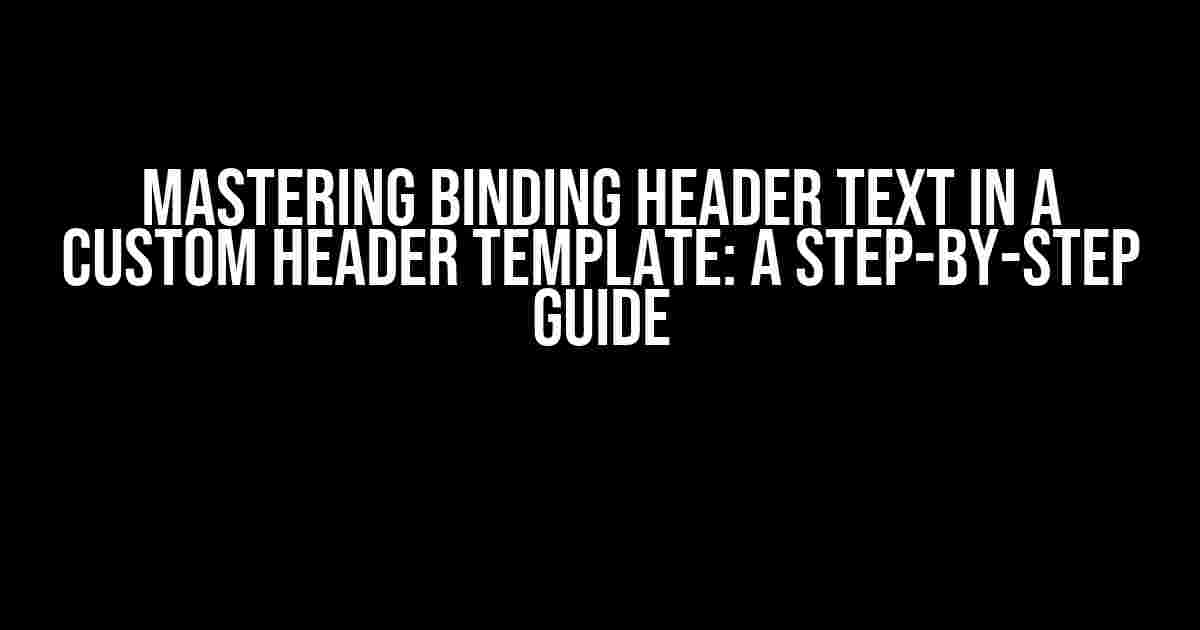Are you tired of dealing with inflexible header templates that limit your design creativity? Do you want to take your headers to the next level by binding them to dynamic text? Look no further! In this comprehensive guide, we’ll show you how to bind header text in a custom header template, giving you the ultimate flexibility and control over your design.
What is Binding Header Text?
Binding header text refers to the process of linking a header element to a dynamic data source, allowing the text to change automatically based on the data. This technique is essential in modern web development, as it enables you to create responsive, user-friendly, and data-driven interfaces.
Why Bind Header Text?
There are several reasons why binding header text is a game-changer:
- Dynamic Content: Binding header text allows you to display dynamic content that changes based on user interactions, data updates, or other external factors.
- Improved User Experience: By binding header text, you can create interfaces that respond to user input, providing a more engaging and interactive experience.
- Increased Flexibility: Binding header text gives you the ability to easily update or change header content without modifying the underlying HTML structure.
Preparation is Key: Setting Up Your Custom Header Template
Before we dive into the binding process, let’s prepare our custom header template. This template will serve as the foundation for our binding magic.
<template id="custom-header">
<header>
<h1></h1>
<p></p>
</header>
</template>
In this example, we’ve created a basic custom header template with an `
` and a `
` element. This template will be used as a starting point for our binding process.
Binding Header Text: A Step-by-Step Guide
Now that we have our custom header template, let’s bind the header text to a dynamic data source. We’ll use a simple JavaScript object to demonstrate the process.
Step 1: Create a Data Source
Create a JavaScript object that will serve as our data source:
const headerData = {
title: 'Welcome to Our Website',
subTitle: 'Your go-to destination for all things web development'
};
Step 2: Access the Template Elements
Use JavaScript to access the `
` and `
` elements within our custom header template:
const headerTemplate = document.getElementById('custom-header');
const headerTitle = headerTemplate.content.querySelector('h1');
const headerSubTitle = headerTemplate.content.querySelector('p');
Step 3: Bind the Header Text
Use the `textContent` property to bind the header text to our data source:
headerTitle.textContent = headerData.title; headerSubTitle.textContent = headerData.subTitle;
At this point, our header text is bound to the dynamic data source. Any changes to the `headerData` object will automatically update the header text.
Advanced Binding Techniques
Now that we’ve covered the basics, let’s explore some advanced binding techniques to take your headers to the next level.
Binding to Array Data
What if you need to bind header text to an array of data? No problem! Use the `map()` method to iterate over the array and bind the text:
const headerDataArray = [
{ title: 'Array Item 1', subTitle: 'Subtitle 1' },
{ title: 'Array Item 2', subTitle: 'Subtitle 2' },
{ title: 'Array Item 3', subTitle: 'Subtitle 3' }
];
headerDataArray.forEach((item) => {
headerTitle.textContent = item.title;
headerSubTitle.textContent = item.subTitle;
});
Binding to Object Properties
Sometimes you need to bind header text to specific object properties. Use the dot notation to access the properties and bind the text:
const headerDataObject = {
title: 'Object Title',
subTitle: 'Object Subtitle',
properties: {
name: 'John Doe',
occupation: 'Web Developer'
}
};
headerTitle.textContent = headerDataObject.properties.name;
headerSubTitle.textContent = headerDataObject.properties.occupation;
Common Binding Scenarios
Let’s explore some common binding scenarios to demonstrate the flexibility of binding header text.
| Scenario | Example |
|---|---|
| Binding to user input |
const userInput = document.getElementById('user-input').value;
|
| Binding to API data |
fetch('https://api.example.com/header-data')
|
| Binding to cookie data |
const cookieData = getCookie('header-data');
|
Conclusion
Binding header text in a custom header template is a powerful technique that unlocks a world of possibilities for dynamic and responsive interfaces. By following this guide, you’ve mastered the art of binding header text and are now ready to take your web development skills to the next level.
Remember, the key to successful binding is to understand the data source and the template elements. With practice and creativity, you can create breathtaking headers that adapt to any scenario. Happy coding!
- What is Binding Header Text?
- Why Bind Header Text?
- Preparation is Key: Setting Up Your Custom Header Template
- Binding Header Text: A Step-by-Step Guide
- Advanced Binding Techniques
- Common Binding Scenarios
- Conclusion
Share your thoughts on binding header text in the comments below!
Frequently Asked Questions
Get answers to your burning questions about binding header text in a custom header template!
How do I bind header text in a custom header template?
You can bind header text in a custom header template by using the `HeaderText` property and setting it to a binding expression that retrieves the header text from your data source. For example, `
What is the purpose of the HeaderTemplate in binding header text?
The HeaderTemplate is a template that defines the layout and content of the header section in a data-bound control, such as a GridView or ListView. By using a HeaderTemplate, you can customize the appearance and behavior of the header section, including binding the header text to a dynamic value.
Can I use data binding to bind header text to a method or property?
Yes, you can use data binding to bind the header text to a method or property. For example, you can use the `HeaderText` property and set it to a binding expression that calls a method or retrieves a property value. For example, `
How do I bind header text to a database value in a custom header template?
To bind the header text to a database value in a custom header template, you can use a binding expression that retrieves the database value. For example, `
Can I bind header text to a resource file or localization string?
Yes, you can bind the header text to a resource file or localization string using the `



